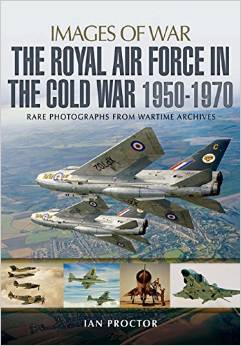It is a pleasing to know that the serious art of in-house photography depicting the day-to-day operations of the UK’s armed forces continues to thrive while so much of the fabric around it suffers the malevolent busying of Mr Austerity’s blunt hacksaw. Whether hindsight looks kindly on current trends is something we can only guess, but safe to say much of the changes we have seen, some irreversible, leave no faith in politicians of any hue and in an election year this disapproval is set to manifest itself with regard to a host of issues.
We have been there before and this terrific full colour book by Ian Proctor illustrates how bad decision making, with hindsight or not, impacted immensely on the Royal Air Force during the Cold War. A particular Aunt Sally would be Duncan Sandys who allowed himself to be convinced that missiles and pilotless aircraft would succeed manned flight so he took a younger version of the hacksaw in use today and did terrible things, not only to the RAF but to the British aviation industry as a result.
But the RAF continued to do all it could with a range of superb aircraft and while
opportunities were squandered by Sandys and his successors the service has continued to make the best of what it has got, especially with that most precious asset of all; it’s people.
The Cold War as we knew it is over and while a new one is predicted by many it is fascinating to look back on those years through the eyes of the RAF photographers snapping every facet of the service to project the power and the glory and also to entice people to join in. The photography isn’t just about shiny jets and hunky pilots; armed forces also need mechanics, cooks and clerks to make them work. The RAF had all these and more and perhaps the cleverest touch in this book is a snap of some apprentice photographers learning their business.
The photographs made by the RAF snappers were of the highest order and this volume includes beautiful aerial images of all manner of aircraft combined with carefully staged shots of ground staff going about their business. Some of these shots have the air of a store catalogue about them and with it comes immense charm.
Mr Proctor’s long service in photo archives has given him the eyes and brains to make a genuinely superb selection from a huge volume of material from the period that the MoD deposited with the Imperial War Museum. The captions are excellent and the overall feel of this book makes it perhaps the best edition from this series I have seen. Some of my colleagues will tell you that isn’t so difficult given the mixed nature of some we have had eyes on but if I needed a book to confirm my faith in the range as a whole, then this is it. It’s only March but I can say without fear that this volume will be in my books of the year round up at Christmastime. I hope we get to see another one covering the years after 1970.
So, let’s do the easy bit. If you have a fondness for the V-Bombers, Javelins and Lightnings or are more at home with the Hastings, Beverley and Belvedere; then this book is an absolute must for you. I can’t make it any simpler than that. But with the addition of happy families outside their RAF housing, young WRAFs in training and technicians maintaining Blue Steel, this book has got the lot. At a penny short of seventeen quid as a cover price, I really can’t see what is stopping you from wanting one. Glorious.
Reviewed by Mark Barnes for War History Online.
THE ROYAL AIR FORCE IN THE COLD WAR 1950-1970
Images of War series
By Ian Proctor
Pen & Sword Aviation
ISBN: 978-1-78383-189-0
